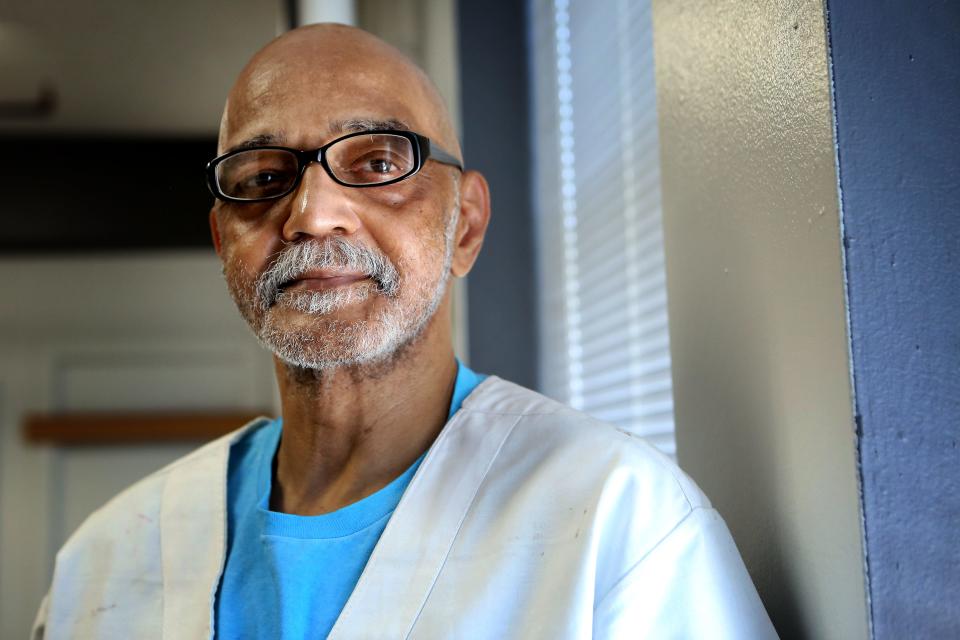Enquirer Community Impact Report 2022
- Oops!Something went wrong.Please try again later.
Stories make a difference.
It may be something the public should know but doesn’t. Or a heart-wrenching story or an uplifting tale that speaks to our humanity. Watchdog journalism, in-depth analysis or just asking questions that need to be asked. That’s what local journalism provides.
Here are 10 times that Enquirer reporting had an impact on the Greater Cincinnati community this past year. Reporters covered schools and politics, opioids and rising rent, the things that matter to people. Shining a spotlight and sharing these stories not only informs people of what is going on, it sparks change. It makes a difference.
Men of color to tutor preschoolers

Back in 2021, education reporter Madeline Mitchell and Canton Repository’s Kelli Weir wrote that 94% of Ohio’s public school teachers are white and identified the need to attract students of color to teacher training programs.
Then, early this year, the Literacy Lab announced 100 men of color were being recruited as tutors for its Leading Men Fellowship, a $4.6 million preschool literacy program coming to Cincinnati in partnership with GreenLight Fund Cincinnati and the state of Ohio. GreenLight’s executive director Clare Zlatic Blankemeyer told the reporters that their article was referenced many times while the project was developed. “Media matters,” Blankemeyer wrote, “…and when articles like yours are circulated broadly, it drives change in our actions and in people’s hearts.”
Community report cards help us know our neighborhoods

The Enquirer staff burrowed through thousands of terabytes of data from the 2020 U.S. Census and other sources to assemble the Cincinnati neighborhood data project, an online resource that features statistics, charts, reports and snapshots of each of the Queen City’s communities. Analysis of the information provides a clearer picture of Greater Cincinnati. Enquirer reporter Dan Horn utilized the data for a statistical and historical look at the reasons for a segregated Cincinnati, such as why 1 in 3 people live in predominantly Black or white neighborhoods. He looked at which neighborhood had the most educated residents and which had the highest drop-out rates. The potential for building more stories of that type from the analyzed community data can help us to better understand ourselves and our neighborhoods.
‘Taken’ documentary and story tells of American hostages

The Enquirer spent seven years investigating the kidnapping of two American defense contractors, Mark McAlister and John Hamen III, in Yemen in 2015. Such a tale needed a special sort of storytelling. The result was “Taken: An American Hostage Story,” told by Keith BieryGolick and Meg Vogel across multiple media platforms: a gripping tale with powerful images as well as a 45-minute documentary produced by Vogel. As they describe it: “This is a story about death and survival. This is a story about what happens after your life becomes national news – when the spotlight fades, but the suffering doesn’t.”
‘Accused’ revisits case of death row inmate Elwood Jones

The fourth season of The Enquirer’s “Accused” podcast, the series that Rolling Stone called one of “the 25 best true-crime podcasts of all time,” focused on the impending execution of Elwood Jones, who has spent nearly three decades on death row after being convicted in the fatal beating of Rhoda Nathan in a Blue Ash hotel room in 1994.
The “Accused” team – Amber Hunt, Amanda Rossmann, Amy Wilson and Phil Didion – virtually “revisited” the crime scene for listeners, examining each step and misstep along the way. Jones has maintained his innocence all these years and his attorneys claim he was framed. He pleaded his case before a Hamilton County Common Pleas Court judge who ordered a new trial for Jones after ruling that evidence was withheld by prosecutors.
Stories on out-of-state landlords buying houses cited in Congress

The Enquirer’s reports were heard in the halls of Congress. Dan Horn and Randy Tucker’s series on corporate investors buying Cincinnati houses, creating neighborhoods of mostly renters, was cited by Laura Brunner, CEO of The Port of Greater Cincinnati Development Authority, in her testimony before the Senate committee on Banking, Housing and Urban Affairs on the housing market forcing higher rents.
Ohio’s Sen. Sherrod Brown, the committee chair, also shared facts he learned from The Enquirer. He spoke about Ashbrook Drive in West Price Hill, where 29 properties are owned by Texas-based VineBrook Homes. “And the city (Cincinnati) is left to chase down these out-of-state landlords who are letting homes fall apart,” Brown said.
Unreported water plant power outage
Reporter Sharon Coolidge turned a “watchdog tip” into a scoop that Greater Cincinnati Water Works' main water treatment plant suffered an unreported 10-hour power outage in May, forcing the city to rely on water from neighboring cities. There was no disruption in service, but the public was not informed until The Enquirer’s story in October, five months after the fact. Coolidge spoke to University of Cincinnati professor Dionysios Dionysiou, an expert in water quality and treatment, who said it was imperative to let the public know so questions can be asked about what could happen during a catastrophic event such as the pump failure in Jackson, Mississippi.
Mason changed arts center plans after story
Mason City Council backtracked on the site chosen for a new regional arts center after The Enquirer reported multiple complaints that such plans violated the wishes of the woman who sold the land to the city. Erin Glynn reported that Eleanor Gould had sold the 50-acre farm with the intent, as laid out in the deed, that the land become a park. The city council voted to pick another site for the arts center. “We listened to you,” Mason Vice Mayor Diana Nelson said at the meeting where they voted on the new location. “We are your councilmembers and we do care about the quality of life that you’re living in Mason and it’s our responsibility to listen.”
Glynn's position as watchdog reporter for Butler, Warren and Clermont counties is funded through a grant from the Report For America program. If you want to support Glynn's work, you can donate to her Report For America position at this website or email her editor Carl Weiser at cweiser@enquirer.com to find out how you can help fund her work.
Communication in the stadium naming rights deal

When the Cincinnati Bengals agreed to sell the naming rights of Paul Brown Stadium to Paycor HCM Inc., many folks wondered what the deal meant for Hamilton County taxpayers, who have footed the bill for the stadium since the controversial half-cent sales tax to fund the stadiums was approved by voters in 1996. The Hamilton County Commissioners were wondering as well, until Scott Wartman reported the answer: Nothing.
Commissioner Alicia Reese said that The Enquirer story was the first she had heard about communications from the Bengals regarding the naming rights. She called for discussion of the deal to be conducted in public, while the Bengals’ attorney Aaron Herzog told The Enquirer, “The lease does not require the Team to share the agreement with the County.” All the communication between the parties seemed to be coming via The Enquirer’s reports using open records requests.
Reporting fentanyl in fake prescription pills

Terry DeMio’s special report on the rise of fake prescription pills containing fentanyl was a public service, informing readers of the dangers of the synthetic opioid and the surge of its appearance in counterfeit prescription medication. “So why does it matter?” DeMio wrote. “Because fentanyl and its cousins – other synthetic opioids that can be made by changing a fentanyl chemical bond – are the main driver for most overdose deaths in America, the U.S. Centers for Disease Control and Prevention says.” DeMio has spent the last several years as The Enquirer’s heroin epidemic reporter, a unique position created for the specific needs of this community.
Covering the culture wars in our schools
The culture war battlegrounds at Forest Hills and Lakota schools have intensified over the last year. Throughout, Madeline Mitchell has been on the scene reporting each development, from the Forest Hills school board passing a resolution that banned critical race theory and anti-racism curriculum to Lakota school board member Darbi Boddy’s unannounced school visits where she photographed a child’s drawing, a civil rights timeline and LGBTQ “I am an ally” stickers on classroom doors. These are stories that affect and concern even people who are not parents, students or teachers in those districts.
This article originally appeared on Cincinnati Enquirer: Enquirer Community Impact Report 2022

